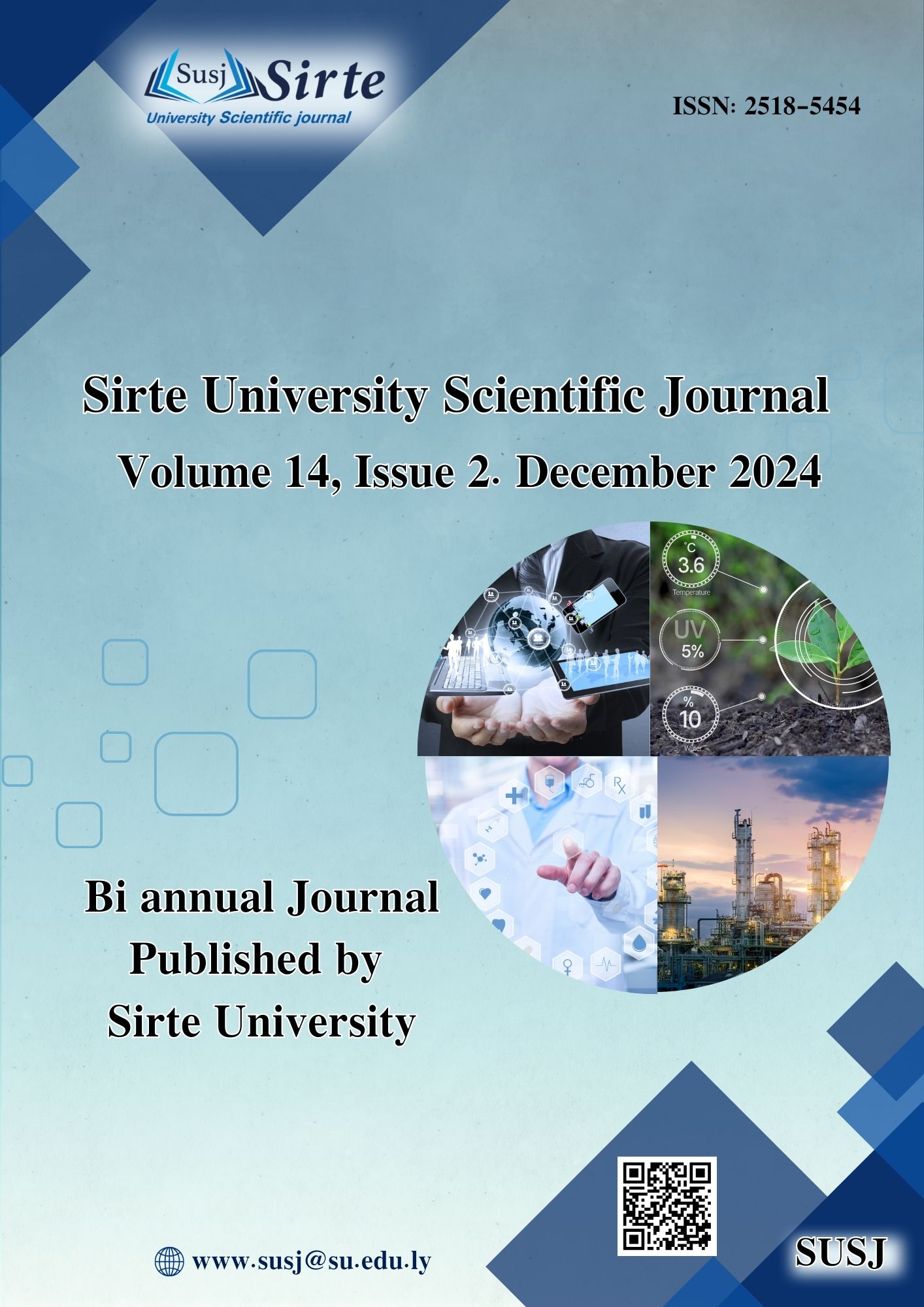Superabsorbent Polymer (SAP) Dehydration by Petroleum Fluids
DOI:
https://doi.org/10.37375/susj.v14i2.3085Keywords:
Oil Effect, Dehydration, Superabsorbent Polymer, Mature ReservoirsAbstract
Water production increases and oil sweep efficiency decreases as a reservoir matures. This water production can be produced from an injection or/and production wells. Water production can be the reason of decreasing and/or increasing oil production on the well operation cost. In the oil industry a lot of oil companies are using Superabsorbent Polymers (SAP) to improve oil production and decrease water production. When SAP mixed with water, it can absorb more than one hundred times their orginal weight. This research was accompanied to study SAP dehydration effect on oil production wells. This work used LiquiBlock’s AT-03S with a mesh of 35-60 (250-500 microns), and LiquiBlock’s 2G-110 with a mesh of 60-120 (125-250 microns). The selected polymers were formed using different particle sizes and brine concentrations. To create a brine of particular salinity, different brine concentrations were prepared by mixing deionized (DI) water with Calcium Chloride, Sodium Chloride, and a mixture of both Sodium Chloride and Calcium Chloride. Venous oil samples used for this work (Black oil, medium oil, and mineral oil). Oil was added to the solution after allowing the polymers to fully swell in brine, which was then agitated and allowed to settle. This research also investigated the effects of temperature on SAP swollen and dehydration. In conclusion, oil dehydration affected the swelling ratio of the polymer. The results of this work can help to select the best polymer which can be used for water shut-off treatment and improve oil recovery on mature reservoirs.
References
Al-Anazi, H. A., Saudi Aramco, and Sharma, M. M. (2002). Use of a pH Sensitive Polymer for Conformance Control. Society of Petroleum Engineers (SPE), SPE paper 73782 presented at the SPE International Symposium and Exhibition on Formation Damage Control held in Lafayette, Louisiana.
Bai, B., Wei, M., and Liu, Y. (2013). Field and Lab Experience with a Successful Preformed Particle Gel Conformance Control Technology. Society of Petroleum Engineers (SPE), SPE paper 164511 presented at the SPE Production and Operations Symposium held in Oklahoma City, Oklahoma.
Brattekas, B., Haugen, A., Graue, A., and Seright, R.S. (2012). Gel Dehydration by Spontaneous Imbibition of Brine from Aged Polymer Gel. Society of Petroleum Engineers, SPE paper 153118 presented at the 18th SPE Improved Oil Recovery Symposium held in Tulsa, Oklahoma, USA.
Ekeigwe, A., Laoye, A., Madu, J., Onwuzurike, C., Williams, O., Shell Petroleum Development Company of Nigeria Limited, Poitrenaud, H., Schlumberger. (2004). Water Shutoff Using Rigid Polymer: The Etelebou Experience. Society of Petroleum Engineers, SPE Paper 88925 presented at the 28th Annual SPE International Technical Conference and Exhibition held in Abuja, Nigeria.
Elsharafi, M., Chancellor, C., Kirby, C., and Ok, J.T. (2016). Hydrochloric Acid Effect on the pH Value of the Superabsorbent Polymer (SAP) Solutions. International Journal of Petrochemical Science & Engineering. Vol 1, Issue 1. Paper 00006.
Elsharafi, M. O., and Bai, B. (2016). Influence of strong preformed particle gels on low permeable formations in mature reservoirs. Pet. Sci. DOI 10.1007/s12182-015-0072-3.
Elsharafi, M. O. (2015). Effect of Back Pressure on Gel Pack Permeability During Conformance Control Treatment. Presented at the 2015 Southwest Section of the AAPG Annual Convention held in Wichita Falls, Texas.
Elsharafi, M. O. (2013). Minimizing Formation Damage for Preformed Particle Gels Treatment in Mature Reservoirs. Dissertation, Missouri University of Science and Technology.
Elsharafi, M. O., and Bai, B. (2012). Effect of Weak Preformed Particle Gel on Unswept Oil Zones/Areas during Conformance Control Treatments. Industrial & Engineering Chemistry Research, pg. 11547-11553.
Krishnan, P., Asghari, K., Willhite, G.P., McCool, C.S., Green, D.W., and Vossoughi, S. (2000). Dehydration and Permeability of Gels Used in In-Situ Permeability Modification Treatments. Society of Petroleum Engineers, SPE Paper 59347 presented at the 2000 SPE/DOE Improved Oil Recovery Symposium held in Tulsa, Oklahoma, USA.
Needham, R. B., & Doe, P. H. (1987). Polymer Flooding Review. Society of Petroleum Engineers (SPE). SPE paper 17140.
Seright, R.S. (1999). Polymer Gel Dehydration During Extrusion Through Fractures. SPE Production and Facilities. Vol 48, Issue 2. SPE Paper 56126.
Slattery, J.C. (1971). The Effect of Interfacial Viscosities in Waterflooding. Society of Petroleum Engineering. SPE Paper 3377.
Xu, W., Ok, J.T., Xiao, F., Neeves, K.B., Yin, X. (2014). Effect of Pore Geometry and Interfacial Tension on Water-Oil Displacement Efficiency in Oil-Wet Microfluidic Porous Media Analogs. Physics of Fluids. paper 093102.
Alhdad GM, Seal CE, Al-Azzawi MJ, Flowers TJ (2013) The effect of combined salinity and waterlogging on the halophyte Suaeda maritima: The role of antioxidants. Environ. Exp. Bot. 87:120-125. https://doi.org/10.1016/j.envexpbot.2012.10.010
Ansari R (1982) Salt tolerance studies in some halophytes, DPhil, University of Sussex, Brighton, UK
Armstrong W, Justin S, Beckett PM, Lythe S (1991) Root adaptation to soil waterlogging. Aquat. Bot. 39 (1-2):57-73. https://doi.org/10.1016/0304-3770(91)90022-w
Colmer TD, Pedersen O, Wetson AM, Flowers TJ (2013) Oxygen dynamics in a salt-marsh soil and in Suaeda maritima during tidal submergence. Environ. Exp. Bot. 92:73-82. https://doi.org/10.1016/j.envexpbot.2012.07.002
Colmer TD, Voesenek L (2009) Flooding tolerance: suites of plant traits in variable environments. Funct. Plant Biol. 36 (8):665-681. https://doi.org/10.1071/fp09144
Duan HM, Ma YC, Liu RR, Li Q, Yang Y, Song J (2018) Effect of combined waterlogging and salinity stresses on euhalophyte Suaeda glauca. Plant Physiol. Biochem.127:231-237. https://doi.org/10.1016/j.plaphy.2018.03.030





